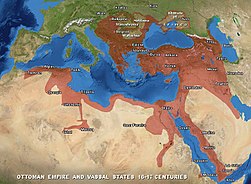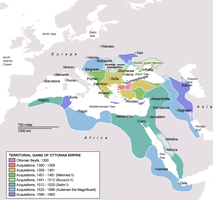| English
|
Ottoman Empire
The Ottoman Empire or Ottoman State was an empire that lasted from 1299 to November 1, 1922. It was succeeded by the Republic of Turkey, which was officially proclaimed on October 29, 1923.
At the height of its power (16th–17th century), it spanned three continents, controlling much of Southeastern Europe, Western Asia and North Africa. The Ottoman Empire contained 29 provinces and numerous vassal states, some of which were later absorbed into the empire, while others were granted various types of autonomy during the course of centuries. The empire also temporarily gained authority over distant overseas lands through declarations of allegiance to the Ottoman Sultan and Caliph, such as the declaration by the Sultan of Aceh in 1565; or through the temporary acquisitions of islands in the Atlantic Ocean, such as Lanzarote in 1585.
The empire was at the center of interactions between the Eastern and Western worlds for six centuries. With Constantinople as its capital city, and vast control of lands around the eastern Mediterranean during the reign of Suleiman the Magnificent (ruled 1520 to 1566), the Ottoman Empire was, in many respects, an Islamic successor to the Eastern Roman (Byzantine) Empire.
|

















